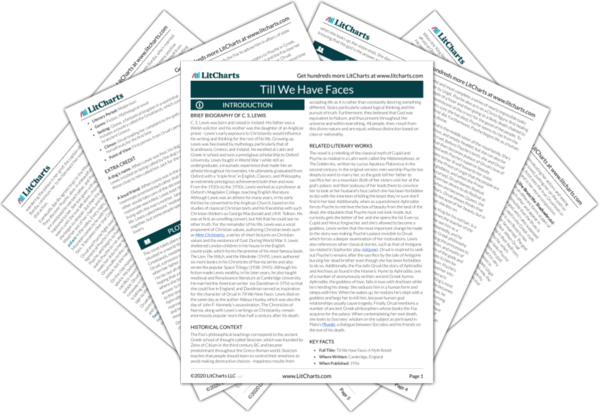Love and Devouring
This novel envisions love first and foremost as a destructive force that consumes the lives of those who feel it. Ungit, the major goddess worshipped in Glome, corresponds to Aphrodite, the Greek goddess of love. Whereas Aphrodite is usually imagined as a beautiful, seductive goddess, Ungit is portrayed as a cruel goddess who demands frequent blood sacrifices, and she is embodied by a chunk of grotesque uncut rock. This symbolism shows that Ungit’s dominating…
read analysis of Love and DevouringJealousy
For Orual, love doesn’t come without jealousy. Her jealousy stems in large part from her ugliness, which makes her very insecure about the affection that anyone shows her, because characters such as the King, Redival, and Batta have always shown their disgust at her appearance and made it clear that she will never be able to marry. Essentially, she has been taught that she is unlovable, so she more easily recognizes the…
read analysis of JealousySelf-understanding
The very title of the book gestures to a need to discover the essence of one’s being and strip away all of the illusions about oneself before the gods can even bother trying to communicate with mortals. Orual asks, “How can they [the gods] meet us face to face till we have faces?” (294).
For much of the book, Orual wears a veil which symbolizes her blindness to the effects of her own actions—she causes…
read analysis of Self-understanding
Earthly vs. Divine
In writing a fundamentally Christian book that focuses on a Greek myth, Lewis manages to mix two quite different religions. In Greek mythology, the gods are almost pettily involved in human life, frequently interacting with mortals in both love and anger and even having children with them. Humans generally don’t become divine unless a god particularly likes them and doesn’t want to lose them to death—people don’t work to gain enough merit to become divine…
read analysis of Earthly vs. DivineJustice
The entire book is, in some sense, Orual’s plea for justice, her statement of the wrongs the gods have done her. First, Ungit demands Psyche as a sacrifice, taking her from Orual’s love to a fate Orual believes will be awful. Once Orual finds Psyche alive, she feels that the gods trick her by not allowing her to see the palace in which Psyche now lives. This tears her apart from Psyche, as she…
read analysis of JusticeBeauty vs. Ugliness
Throughout the novel, the characters’ physical appearances often reflect their interior morality and goodness. However, it’s difficult to say for sure whether characters’ appearances are only symbols of their true beings, or whether their appearances and the way others interact with them as a result forms their interior for good or evil. Specifically, Orual is taught from an early age that her ugliness will prevent her from marrying, and that people will want to keep…
read analysis of Beauty vs. Ugliness











